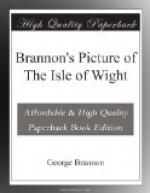in 530, who replaced the slaughtered British by a colony
of his own countrymen; and Ceadwalla of Murcia,
who having seized it in 686, was so incensed
at the idolatry of the inhabitants, that he resolved
at first to extirpate them, and repeople the island
with Christians! but at the intercession
of bishop Wilfred, great numbers saved their
lives by submitting to be baptized.
In the ninth and following centuries the island suffered, in common with the neighbouring coast, from the predatory visits of the Danes. For a time indeed they were checked by the great Alfred, who wholly captured or destroyed one large fleet, laden with the spoils of Hampshire and the Wight: but under the weak and disordered reigns of his successors, the northern pirates seem to have taken possession of this defenceless spot as often as they pleased; and after making it a depot for the plunder of the adjacent counties, and living freely on the inhabitants, sometimes wantonly burned towns and villages at their departure.
The island was also severely harrassed by some of the rebellious Saxon nobles in the reign of Edward the Confessor; but after the Norman Conquest, its tranquillity was not materially disturbed till the year 1346, when a party of French landed at St. Helen’s; they were soon repulsed by the islanders, though the warden, Sir Theobald Russell, was amongst the slain. About this time a variety of excellent regulations were made by the inhabitants for their better security: the landholders were by their tenures bound to defend the castle of Carisbrooke for 40 days at their own charges; the county of Devon sent for its defence 76 men-at arms, and the city of London 300 slingers and bowmen.
Another party of the French seem to have made a more successful attack in the first year of Richard II: indeed the islanders at that time had little besides their own valor to depend on for protection; as there were no forts to obstruct an enemy’s landing; Carisbrooke Castle standing in the centre of the island, could only serve for a partial retreat: and serious ravages might be committed ere any assistance arrived from the mainland. This want of domestic security so discouraged the natives, that many families withdrew, when an order was issued to the wardens to seize the lands of all such as refused to return.
Not long afterwards a powerful body of Frenchmen landed in the island, the militia of which (900 in number,) had been reinforced from Southampton and London, in expectation of this hostile visit. The invaders were unable to reduce Carisbrooke Castle, which was commanded by the governor, Sir H. Tyrrel—and moreover suffered considerable loss by an ambuscade at a place near Newport, still called Deadman’s Lane; [Footnote: A tumulus where the slain were buried, at the south entrance to the town, was exultingly named Noddies’ Hill—whence the present appellation Nodehill.]




